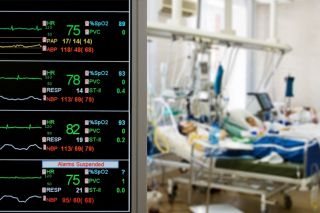Media
Shock Is Bad, but What Is It?
On television, patients go into shock all the time. It's bad. Here's why.
Posted February 1, 2014
So you’re watching Grey’s Anatomy--or reruns of ER because we all know George Clooney is soooo hot—and some patient goes into shock. This news sounds bad. After all, when is shock ever good (shell shock, aftershock, shock and awe)? Our compassionate television physicians (with their bevy of personal problems) leap into action in order to save the patient’s life, and they do! They’ve saved a patient from shock! But what is shock?

Shock is a medical emergency that results from inadequate circulation to tissues. This inadequate circulation means less oxygen for cells which results in cellular injury. In a failed attempt to compensate, these oxygen-starved cells kick out damage-associated molecular patterns (DAMPs or “damage signals”) and inflammatory mediators which trigger inflammation. “Danger signals” and inflammatory mediators make the situation worse and further compromise circulation at the level of the smallest blood vessels. If left untreated, this vicious cycle can result in organ failure and death.
The major clinical symptom associated with shock is a big drop in blood pressure which makes sense because circulation is seriously impaired. More specifically, the mean arterial pressure, or average blood pressure during several heart beats drops to below 60 mm Hg.
Shock can have many causes:
• hypovolemic shock caused by blood loss (hemorrhage);
• traumatic shock including structural damage to the heart, chest or head;
• septic shock caused by infection;
• cardiogenic shock or shock caused by heart damage;
• neurogenic shock caused by injury to the spinal cord;
• hypoadrenal shock caused by decreased release of the hormone cortisol in light of injury, illness or operation.
Shock needs to be quickly treated before damage becomes irreversible and death becomes inevitable. Treatment includes administration of fluids (to restore volume), medications that increase heart rate or heart muscle contractility (dobutamine, dopamine or epinephrine) and concomitant treatment directed toward the cause of shock—stopping hemorrhage, administering antibiotics for infection and so forth. Of note, fluid resuscitation can result in hypothermia (a drop in body temperature) and oftentimes patients need to be rewarmed.
So now you know what shock is. In fact, you probably understand shock better than many of the “physicians” on your favorite television show!
Any thoughts? As always, comments are welcome ...
Want to learn to write like a pro? Read my new book The Complete Guide to Article Writing: How to Write Successful Articles for Online and Print Markets (F+W Media/Writer’s Digest Books). RSVP to attend the online book launch at Shindig on 2/14/2014 between 6 p.m. and 7 p.m. ET.
Follow me on Twitter!
Sources:
Maier RV. Chapter 270. Approach to the Patient with Shock. In: Longo DL, Fauci AS, Kasper DL, Hauser SL, Jameson J, Loscalzo J. eds. Harrison's Principles of Internal Medicine, 18e. New York: McGraw-Hill; 2012. http://accessmedicine.mhmedical.com.proxygw.wrlc.org/content.aspx?booki…. Accessed February 01, 2014.
http://courses.washington.edu/conj/circulation/reflectedPulse.htm. Accessed February 01, 2014.


